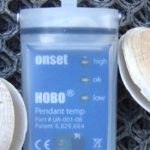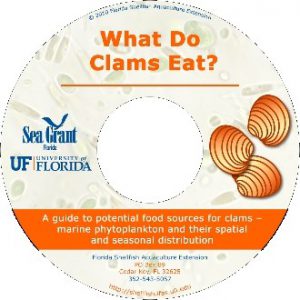Home » Projects » Shellfish Farm Environment Projects » Decision-Support Tools for Florida Clam Farmers
Several applied projects were continued or developed in 2010 to assist Florida clam farmers in making timely and informed management decisions regarding their crops.
A partnership developed by the Shellfish Aquaculture Extension Program (SAEP) with federal and state agricultural agencies allows for continued operation and maintenance of water quality and weather monitoring stations. Currently, stations are located at five lease areas in four coastal counties (Dixie, Franklin, Indian River, and Levy). These stations provide timely information to clam growers, allowing them to make management decisions based on temperature, salinity, and other measurements. Continuous “real-time” data are made available at http://shellfish.ifas.ufl.edu, along with archived data in monthly and annual graphic format.
Water temperature plays an important role in biology and directly affects the bodily functions of aquatic organisms necessary for growth and survival. It also influences water quality parameters, such as dissolved oxygen and pH. An ongoing monitoring project is providing detailed and broad coverage of water temperatures by deploying inexpensive data loggers at multiple clam aquaculture leases to adequately describe variability potentially due to water depth, substrate characteristics, currents, or other parameters. The water-proof data loggers used for this project (pictured at right) are small, allowing them to be placed directly inside a clam bag on the lease site. In 2009, 37 data loggers were deployed by Cedar Key growers providing 10% coverage of the Gulf Jackson and Pelican Reef lease areas and 25% coverage of the Dog Island and Corrigan’s Reef lease areas. Peak water temperatures were recorded in August with maximum values (93.8oF) recorded on August 12. Temperatures ranged from 90.3 to 92.7°F on other leases at that time. During the month of August, temperatures exceeded 90°F on 15 days. These values are important to production as clams cease growth processes at approximately 88°F, and stop filtering around 90°F. In 2010, a similar number of data loggers were deployed. Two water temperature peaks occurred in which >90oF temperatures were recorded. The first occurred in mid-July and then, again, in August with maximum values of 95.8oF reached on August 3, while temperatures ranged from 90.7°to 94.4°F on other leases at that time. Temperatures on the Gulf Jackson leases reached 90°F or higher on 10-12 days during August. Alternately, temperatures on the Corrigan’s Reef leases reached 90°F or higher for 7-12 days.
functions of aquatic organisms necessary for growth and survival. It also influences water quality parameters, such as dissolved oxygen and pH. An ongoing monitoring project is providing detailed and broad coverage of water temperatures by deploying inexpensive data loggers at multiple clam aquaculture leases to adequately describe variability potentially due to water depth, substrate characteristics, currents, or other parameters. The water-proof data loggers used for this project (pictured at right) are small, allowing them to be placed directly inside a clam bag on the lease site. In 2009, 37 data loggers were deployed by Cedar Key growers providing 10% coverage of the Gulf Jackson and Pelican Reef lease areas and 25% coverage of the Dog Island and Corrigan’s Reef lease areas. Peak water temperatures were recorded in August with maximum values (93.8oF) recorded on August 12. Temperatures ranged from 90.3 to 92.7°F on other leases at that time. During the month of August, temperatures exceeded 90°F on 15 days. These values are important to production as clams cease growth processes at approximately 88°F, and stop filtering around 90°F. In 2010, a similar number of data loggers were deployed. Two water temperature peaks occurred in which >90oF temperatures were recorded. The first occurred in mid-July and then, again, in August with maximum values of 95.8oF reached on August 3, while temperatures ranged from 90.7°to 94.4°F on other leases at that time. Temperatures on the Gulf Jackson leases reached 90°F or higher on 10-12 days during August. Alternately, temperatures on the Corrigan’s Reef leases reached 90°F or higher for 7-12 days.
Clam farms are located on submerged land leases in inshore coastal waters. Florida’s warm climate supports year-round productivity and good growing conditions for hard clams. Knowledge of what clams eat and when those food items are most available can guide farmers in deciding when to plant seed and harvest clams. In addition, information on patterns of occurrence of harmful algal blooms can help farmers avoid or anticipate losses in clam sales or stocks. A web-based, pictorial guide was developed to assist farmers in identifying potential food sources for clams and their spatial and seasonal distribution. Measures of phytoplankton quantity (chlorophyll a patterns) and quality (biomass patterns), as well as species data, from two clam aquaculture regions (Indian River near Sebastian and Suwannee Sound) are presented in this guide. Biographical sketch pages describe over 50 common algal species with information about where and how often the species was found in samples from University of Florida phytoplankton studies, and whether the food is good (nutritious) or bad (noxious or harmful) for clams. The educational tool What Do Clams Eat? is accessible at http://shellfish.ifas.ufl.edu and available as a CD-ROM.
warm climate supports year-round productivity and good growing conditions for hard clams. Knowledge of what clams eat and when those food items are most available can guide farmers in deciding when to plant seed and harvest clams. In addition, information on patterns of occurrence of harmful algal blooms can help farmers avoid or anticipate losses in clam sales or stocks. A web-based, pictorial guide was developed to assist farmers in identifying potential food sources for clams and their spatial and seasonal distribution. Measures of phytoplankton quantity (chlorophyll a patterns) and quality (biomass patterns), as well as species data, from two clam aquaculture regions (Indian River near Sebastian and Suwannee Sound) are presented in this guide. Biographical sketch pages describe over 50 common algal species with information about where and how often the species was found in samples from University of Florida phytoplankton studies, and whether the food is good (nutritious) or bad (noxious or harmful) for clams. The educational tool What Do Clams Eat? is accessible at http://shellfish.ifas.ufl.edu and available as a CD-ROM.
Leslie Sturmer, University of Florida IFAS, Shellfish Aquaculture Extension
Ed Phlips, Nikki Dix, Shirley Baker, University of Florida SFRC, Fisheries & Aquatic Sciences
Kevin Hulen, University of Florida, Biological Sciences